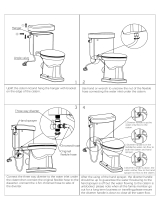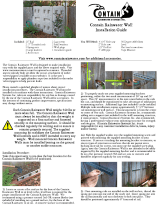Page is loading ...

RAINWATER HARVESTING
INSTALLATION GUIDE
RH9521-12
High Capacity Vortex Rainwater Fine Filter
for
Above or Below Grade Application

RH9521-12 Vortex Filter
Operation and Maintenance
Overview
The RH9521-12 Vortex Filter harvests up to 95% of the
rooftop rainwater runoff from a roof area up to 33,000 sq.
ft. Particulate is separated and diverted from the rainwater
through the vortex action to protect the harvested water
quality prior to entering the storage tank (cistern). The
Vortex Filter is used primarily for below ground installations
where multiple downspouts are connected to a single trunk
line. The RH9521-12 can be used for above ground
applications and can be mounted with a custom-made
stand or bracket, supplied by others. The trunk line feeds into the centrally located Vortex Filter.
• Particles larger than 380 microns are diverted into the storm drain.
• The full cross-section of the rainwater drainage system remains continuously open in the
RH9521-12 system. There are no restrictions or obstructions in the filter on which debris can
collect.
• The filter element develops it’s maximum efficiency when the filter mesh has been completely
wetted. After a dry period, this can take up to 2 minutes. This first flush action diverts the entire
initial flow of water into the storm drain. After the filter is completely saturated, filtered water will
be delivered to the cistern.
• If necessary, (for deeper underground installation) an extension can be installed up to ground
level (accessory).
• The rainwater inlet can be turned 360° in relation to the lower section. The central drain outlet is
vertical so that pipes can be connected in any direction.
Installation
Pre-planning is critical. It is recommended that the filter be in place before trunk lines are run and the
tank is buried for below ground applications and prior to constructing a platform for above ground
applications.
1

Below Ground
Remove the steel or aluminum cover and the internal packing material. Prior to installing the filter, a
12" pipe will need to be buried with a 90° elbow to receive the discharge pipe at the bottom of the
filter. This pipe will need to be installed to carry first flush water and debris to grade or to storm as
applicable.
Place the stainless steel base over the elbow on a firm base of gravel or pre-poured concrete slab.
The base plate should rest level on the concrete platform or compacted area with the end of the
elbow visible through the round opening in the base plate. Make certain the base plate rests flat on
the ground or concrete slab. If there are void areas, they must be filled in.
Insert the housing of the RH9521-12 into the open elbow through the opening in the stainless steel
base plate. It is critical that the vertical pressure of the RH9521-12 housing is absorbed completely by
the base plate. If any of the weight is not distributed properly, adjustments to the base plate will be
necessary.
Rotate the rainwater inlet to the required direction to meet the incoming trunk line from the
downspouts. Rotate the clean water outlet to the required direction to connect to the tank.
Remove the pipe inlet protector from the rainwater inlet on the filter by removing the rubber seal ring
from the inlet bushing. Push the inlet protector out from the inside and replace the rubber seal ring in
the inlet bushing. Make the connection from the trunk line to the filter using a minimum of 40" of
horizontal 12" pipe to reduce the velocity of flow and calm the water to maximize efficiency. The 8"
inlet pipe to the tank should be attached to the clean water outlet on the filter and the inlet of the tank
using a minimum 1/8" fall per linear foot to ensure gravitational flow to the tank.
Once all connections are made and the filter has been checked to ensure it is level and plumb,
backfill the filter using gravel or wet sand.
If the top of the filter housing is below grade, an extension can be added to the filter. The child
protection plate must be removed from the ring and moved to the top ring once installed. The
extension is then placed in the ring on the top of the filter and secured using stainless steel screws
with washers and nuts. An additional top ring will be necessary to support the top of the extension
and receive the child protection plate and lid. Once the exact length of the extension is determined,
remove the excess.
Secure the intermediate ring to the top of the extension ring using stainless steel screw with washers
and nuts and attach the child protection plate. The lid can then be placed on the filter and the
remaining backfilling can take place.
Note: Please see the additional installation notes included at the end of this section.
2

Above Ground
Remove the steel or aluminum cover and the internal packing material.
Create a level and stable platform above the storage tank for which the base plate of the filter can
sit. It is important that the platform is designed to ensure the weight of the filter is absorbed by the
base plate. Do not hang filter or strap filter. Hanging or strapping the filter could change the shape of
the filter and will reduce filter efficiency and cause filter to malfunction. A safety rail should be
constructed around the platform to provide a safe area to view and maintain the filter.
Connect and divert all downspouts to a 12" trunk line to the vortex filter rainwater inlet of the filter
using the standard minimum of 1/8" fall per linear foot.
Remove the pipe inlet protector from the rainwater inlet on the filter by removing the rubber seal ring
from the inlet bushing. Push the inlet protector out from the inside and replace the rubber seal ring in
the inlet bushing. Make the connection from the trunk line to the filter using a minimum of 10' of
horizontal 12" pipe to reduce the velocity of flow and calm the water to maximize efficiency. The 8"
inlet pipe to the tank should be attached to the filtered water outlet on the filter and the inlet of the
tank using a minimum 1/8" fall per linear foot to ensure gravitational flow to the tank. Connect a 12"
pipe to the bottom opening on the filter to carry the first flush water and debris to grade or storm as
applicable.
Once all connections are made, be sure the filter has been installed level and plumb.
Note: Please see the additional installation notes included at the end of this section.
Additional Installation Notes:
1. Ensure the lid is never obstructed or buried. Access is necessary for maintenance.
2. The vortex filter inlet and outlets rotate to fit installation needs.
3. Longer filter handles are available for deeper installations.
4. Adequate space (36") above filter lid must be allowed for filter removal.
5. When connecting a smaller inlet piping, an eccentric piping connector must be used to
ensure connecting pipe's invert is level.
NOTE: When required, the
use of an eccentric reducer
is required to reduce turbulence.
120"(305 cm) required min.
3

6. Be sure to contact your supplier before deviating from these instructions.
7. The filter should never be buried at a depth over 48". If the filter must be placed below
ground deeper than 48", it will be necessary to place the filter in a vault. Placing the filter
more than 48" below ground without a vault could compromise the structural integrity of the
filter housing.
Top View Side View
Maintenance:
The housing of the RH9521-12 is maintenance-free. It consists of non-corrosive plastic. The filter
mesh is virtually self-cleaning by the action of water flowing over the vertical mesh. Nevertheless, a
thin film will build up on the mesh over a period of time. Usually this does not effect the efficiency of
the appliance, but we recommend taking out the filter insert from time to time and spraying any
openings that have become clogged from the inside with a strong jet of water (garden spray or
high-pressure cleaner). Cleaning can also he carried out by hand using a small brush (not a wire
brush) and normal dishwashing liquid.
Removing The Filter:
• Lower the filter handle onto the top of the
filter, position the flat part under the lugs
and lift the filter out.
• Do not leave the filter handle attached after
use. It will impede the water flow and lower
the efficiency of the filter.
11 3/4"
(300) DIA
16 1/8"
(410)
7 7/8"
(200) DIA
35 7/8" (913)
31 7/8" (810)
28" (710) DIA
34 3/4"
(880)
20 3/4"
(525)
7 7/8"
(200) DIA
30 1/2" (776)
SQ Base Plate
11 3/4"
(300) DIA
4 1/4"
(110)
2 1/4"
(56)
28 1/4"
(719) DIA
45 15/16"
(1067)
37 11/16"
(957)
34 7/8"
(884)
20"
(510)
11 3/4"
(300)
DIA
4

Accessories:
Extension pipes are available for the installation of the RH9521-12. These raise the inspection
opening to ground level. They are fitted onto the final ring, which then acts as an intermediate ring.
The extension pipes are fitted with a final ring on one side to provide for the insertion of the manhole
cover and make paving around the cover possible.
Components:
1 Cover
2 Filter
3 Lifting Lug
4 Opening
5 Locating Ring for lid
or extension tube
6 Upper Housing
7 Housing Ring
8 Rainwater Inlet
9 Lower Housing
10 Filtered water Outlet
11 Waste water Outlet
12 Deflecting ribs
13 Stream in level
14 Clean water collection ring
15 Inlet seal
16 Filter element seal
17 Steel baseplate
18 Filter lifting handle
19 Extension tube (accessory)
19
5
3
6
7
9
17
12
13
2
1
4
8
15
16
14
10
11
4 5
18
5

Damage in transit
Products are carefully checked before shipping, but the risk
of damage during transport cannot be guaranteed.
• Check the goods for content and damage on receipt.
• Any damage is the responsibility of the carrier, register any
claim with them immediately.
• Contact your supplier before returning any goods.
JAY R.
SMITH MFG. CO.
®
MEMBER OF MORRIS GROUP INTERNATIONAL
POST OFFICE BOX 3237
MONTGOMERY, ALABAMA 36109-0237 (USA)
TEL: 334-277-8520 FAX: 334-272-7396
www.jrsmith.com
CUSTOMER
DRIVEN
SMITH
®
MEMBER OF:
®
ASPE
®
S
A
N
I
T
A
R
Y
E
N
G
I
N
E
E
R
I
N
G
P
r
e
v
e
n
t
i
o
n
R
a
t
h
e
r
T
h
a
n
C
u
r
e
SINCE 1926
PM 1204 D
WARNING: Cancer and Reproductive Harm - www.P65Warnings.ca.gov
/






